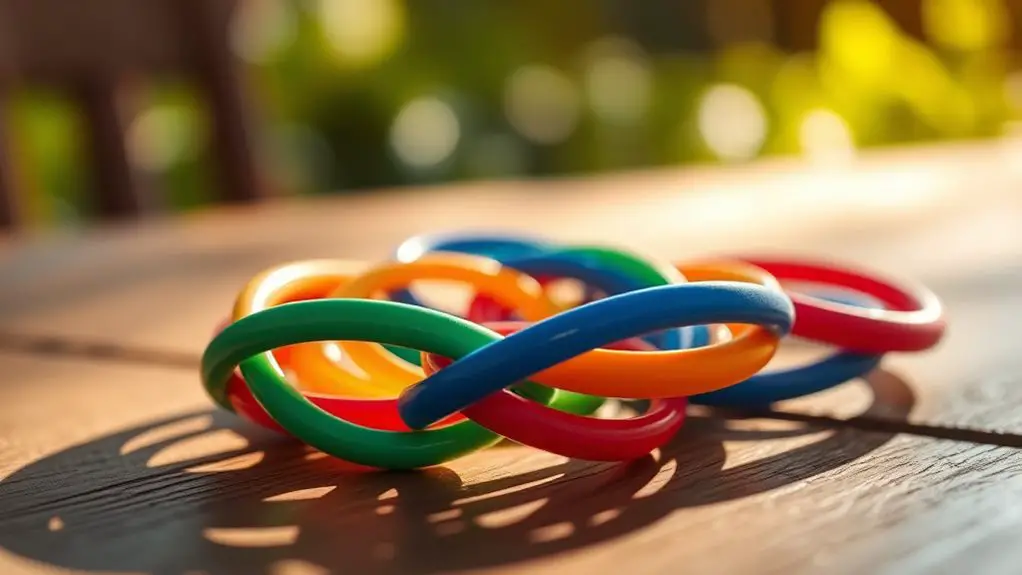The plastic thing that holds a six-pack together is called a six-pack ring, or sometimes a beverage ring. These little loops have been around since the 60s and were a game changer compared to older carriers. Unfortunately, they're a big problem for the environment since they can take hundreds of years to break down and often harm marine life. Thankfully, some companies are now exploring eco-friendly alternatives, like biodegradable or even edible options. So, if you're curious about how these carriers impact our planet and what you can do, there's definitely more to discover!
Key Takeaways
- The plastic item that holds a six-pack together is commonly known as six-pack rings or beverage rings.
- Industry terminology refers to these plastic carriers as can carriers.
- They were invented in the 1960s and became popular by the 1970s.
- These rings are primarily made from plastic, although biodegradable options are emerging.
- Significant environmental concerns arise from their long decomposition time and impact on marine life.
Terminology and Common Names
When you grab a six-pack of your favorite drinks, you might notice those plastic rings holding everything together. Those handy little things are commonly known as six-pack rings or beverage rings.
They've been around since the 1960s and quickly became a staple in the beverage packaging world by the 1970s. The term "six-pack rings" really nails their job—keeping those six cans of beer or soda secure for easy transport.
But here's a fun fact: in the industry, these plastic rings are often referred to as can carriers.
They're mainly made from plastic, but thanks to some innovative thinkers, biodegradable options are popping up too. It's great to see the shift toward more eco-friendly choices, considering how many of these plastic rings end up in our environment.
Historical Background
The history of six-pack rings is a fascinating journey through convenience and environmental awareness. You mightn't realize it, but these plastic holders, which we now call plastic six-pack rings, were first invented in the 1960s. They quickly replaced paper and metal carriers, becoming the go-to packaging option for beverages by the 1970s. Everyone loved the ease of grabbing a six-pack without the fuss of other materials.
However, with convenience came concerns. By 1977, Vermont enacted the first law against non-degradable ring carriers, sparking a movement that saw 27 states follow by 1991 due to rising plastic waste issues.
As awareness grew, so did innovation. The 1990s brought proposals for more natural and photodegradable options for six-pack rings. Manufacturers began exploring alternatives like biodegradable rings and cardboard carriers, addressing the environmental challenges that earlier designs created.
This transformation reflects not just a shift in packaging but a significant change in how we view our impact on the planet. So next time you grab a six-pack, think about the journey those rings have taken!
Environmental Impact
It's eye-opening to think about how those convenient six-pack rings are impacting our environment. You might grab a six-pack without realizing it contributes to a bigger problem.
In fact, the lightweight design of these rings adds to the littering issues that plague marine environments, similar to how plastic bags contribute to environmental strain.
Here are some facts to consider:
- Over 1 million marine animals die each year due to plastic waste, including those pesky six-pack rings.
- They take hundreds of years to decompose, leaving a long-lasting trail of environmental damage.
- As they break down, they turn into microplastics, which can mess with marine ecosystems and the food chain.
- Birds and sea turtles often mistake these rings for food, leading to ingestion, starvation, and serious health issues.
Innovations and Alternatives
As we wake up to the harsh realities of plastic pollution, companies are stepping up with innovative solutions that could change the game for six-pack packaging.
Saltwater Brewery got the ball rolling back in 2010 with their biodegradable six-pack rings made from wheat and barley. These aren't just eco-friendly; they're safe for marine life to munch on if they get loose. How cool is that?
Fast forward to 2018, and Carlsberg Breweries introduced a glue-based carrier that ditches traditional plastic rings altogether. This is a big deal in cutting down environmental impact.
Plus, manufacturers are experimenting with photodegradable materials that break down in months—though we've still got to watch out for those pesky microplastics.
Coors Light is also jumping on the bandwagon, planning to switch to cardboard wrap carriers by 2025, which could reduce plastic waste by a whopping 1.7 million pounds annually.
With options like barley straw-based rings and even edible six-pack ideas floating around, the beverage packaging industry is truly embracing eco-friendliness.
It's an exciting time to see how these innovations can shape a cleaner future!
Consumer Awareness and Actions
With all these innovative packaging solutions popping up, it's clear that consumer awareness is on the rise when it comes to the environmental impact of six-pack rings. More people like you're taking steps to help the planet and push for better packaging.
Here are some actions you can take:
- Cut those six-pack rings before tossing them—this simple act can save marine life.
- Seek out eco-friendly brands that offer biodegradable or reusable options for your favorite drinks.
- Participate in local clean-up events to help tackle plastic pollution in your community.
- Stay informed through educational campaigns about the dangers of plastic pollution and get others involved.
You're not just a consumer; you're part of a movement for Environmental Protection. Brands are listening to your demand for sustainable options, and together, you can make a real difference.
Every small action counts, and by being mindful of your choices, you're helping to reduce plastic waste and protect wildlife.
Frequently Asked Questions
What Holds Beer Cans Together?
When you're grabbing a six-pack, those plastic rings hold the cans together. They make it easy to carry your drinks, but you gotta remember to recycle them to help keep our oceans cleaner.
What Are the Plastic Soda Holders Called?
Those plastic soda holders you see are often called six-pack rings. They've been around since the '60s, and while they're handy, you should be aware of their environmental impact. Consider biodegradable options next time!
What to Do With Plastic Six-Pack Holders?
When dealing with plastic six-pack holders, cut them up before tossing them. Recycling's great, but if that's not an option, consider joining community clean-ups to help keep our beaches and spaces clean.
What Holds Soda Cans Together?
When you're grabbing some soda, those plastic rings are what holds the cans together. They're handy but can be harmful to wildlife. Consider switching to eco-friendly options next time you stock up!

